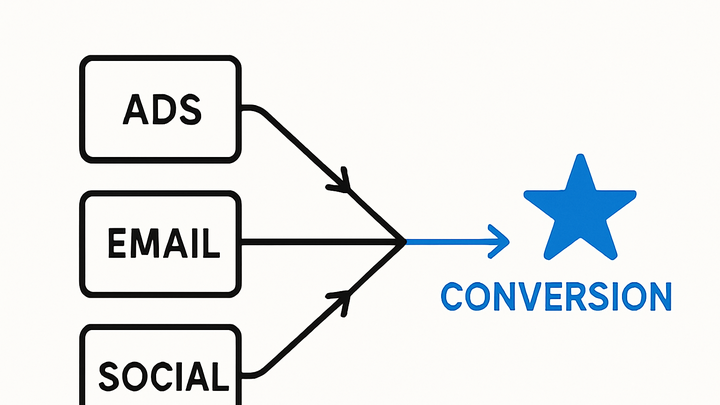Published on 2025-06-28T04:05:15Z
What is Last Click? Examples for Last Click Attribution
Last Click is an attribution model in digital analytics that assigns 100% of conversion credit to the user’s final interaction before converting. It simplifies campaign measurement by focusing on the last touchpoint, making it easy to implement and interpret. This model is the default in many platforms like Google Analytics Universal (last non-direct click) and is available in GA4 under Attribution Settings. While Last Click provides clear insights into bottom-funnel performance, it overlooks earlier touchpoints that may have influenced the decision. Marketers often use it alongside other models or qualitative data to get a more complete view of the customer journey.
Last click
An attribution model that gives 100% credit to the final click before conversion, highlighting last-touch channel performance.
Definition and Context
In digital analytics, Last Click Attribution refers to the method of assigning all conversion credit to the user’s final click or interaction before completing a conversion. It is one of the simplest and most widely used attribution models, serving as the default in many analytics platforms. By focusing solely on the last touchpoint, it offers clear insights into which channels drive immediate results. However, it may overlook the influence of earlier interactions in the customer’s journey. Understanding its context helps marketers choose when and how to apply this model effectively.
-
Core definition
Last Click Attribution credits 100% of a conversion to the final marketing interaction (typically a click) preceding the desired action.
-
Default analytics usage
Many platforms use Last Click or Last Non-Direct Click as their default model, including Universal Analytics and simplified tools like PlainSignal.
-
Universal analytics
Uses Last Non-Direct Click by default, ignoring direct visits that follow other channels.
-
GA4
Offers multiple models but often interpreted in reports as Last Click when viewing basic channel groupings.
-
How Last Click Attribution Works
Last Click Attribution tracks the sequence of user interactions and assigns full credit to the final click that leads to a conversion. This straightforward mechanism makes implementation and reporting easy but can oversimplify complex user journeys.
-
User journey breakdown
Each touchpoint (ads, emails, social posts) is logged, but only the final click is marked as the conversion-driving event.
-
Credit assignment mechanism
The model algorithmically sets the value of the conversion to the last interaction, disregarding the specific channels of earlier touches.
-
Simplicity
Easy to calculate and interpret without complex weighting.
-
Bias risk
Overvalues bottom-funnel channels and undervalues upper-funnel activities.
-
Implementing Last Click in SaaS Tools
Below are examples of how to configure and use Last Click Attribution in PlainSignal and Google Analytics 4 (GA4).
-
PlainSignal (cookie-free analytics)
PlainSignal uses a Last Click model by default. To set up tracking, include the PlainSignal snippet on your pages:
-
Tracking code example
<link rel="preconnect" href="//eu.plainsignal.com/" crossorigin /> <script defer data-do="yourwebsitedomain.com" data-id="0GQV1xmtzQQ" data-api="//eu.plainsignal.com" src="//cdn.plainsignal.com/plainsignal-min.js"></script>
-
-
Google analytics 4 (GA4)
In GA4, you can view Last Click data by customizing your attribution model in reports. Steps:
-
Attribution settings
Go to Admin > Attribution Settings and select ‘Last Click’ as the reporting model.
-
Model comparison
Use the Model Comparison report to switch between Last Click and other models for analysis.
-
Advantages and Limitations
Understanding both strengths and weaknesses of Last Click Attribution helps marketers decide when it’s appropriate to rely on it and when to supplement it.
-
Advantages
Provides quick insights into which channels drive final conversions and is simple to implement.
-
Easy interpretation
Stakeholders can quickly see which last-moment channels perform best.
-
Low complexity
Requires minimal setup without advanced modeling.
-
-
Limitations
Ignores the influence of all prior touchpoints, potentially misrepresenting true channel performance.
-
Channel bias
Overemphasizes bottom-funnel tactics like paid search or direct traffic.
-
Incomplete journey view
Misses the role of brand awareness and engagement activities.
-
Best Practices for Using Last Click
To maximize the value of Last Click Attribution, combine it with other methods and contextual data.
-
Combine with multi-touch models
Use multi-touch or data-driven attribution alongside Last Click to capture the full user journey.
-
Supplement with qualitative insights
Collect user surveys or feedback to understand non-click influences like word-of-mouth.
-
Monitor regularly
Compare Last Click data over time to detect shifts in channel performance and user behavior.
